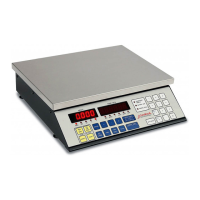SAMPLING AND COUNT ACCURACY, Cont.
INDIVIDUAL PART WEIGHT VARIANCE
For a given sample quantity, as the total weight of all parts in the sample increases, the average
per-piece weight of the sample used becomes representative of the average per-piece weight of
the group of parts to be counted. The errors caused by part weight variance are reduced with
larger sample quantities. With knowledge of the typical percentage of variartion in per-part
weight of items to be counted, refer to the graph in Figure No. 10 to determine the sample
quantity needed to obtain a desired percentage of counting accuracy.
As your need for counting accuracy increases, the size of your samples must
also increase.
As individual uniformity of your parts decreases, sample size must increase.
Manual counting errors may occur if samples larger than necessary are used.
Because of variation of individual container weights, be certain to "tare off" each
container by placing the empty container on the scale and pressing the ZERO
key before proceeding with the count operation.
Figure No. 10
1. Select the typical % of variation in the sample part-weight on the
left-hand side of the graph.
2. Follow the selected curve to the right and upward to the % of
sample accuracy.
3. Read down vertically from the % of accuracy to the corresponding
minimum quantity of parts required for sampling to obtain the
desired minimum % of count accuracy.
NOTES:
32
% OF SAMPLE ACCURACY
97% 98% 99% 99.5%
5%
4%
3%
1%
0.5%
% VARIATION
QUANTITY OF PARTS SELECTED FOR SAMPLING
5 10 25 50 100 250
2%
IN SAMPLE
PART WEIGHT

